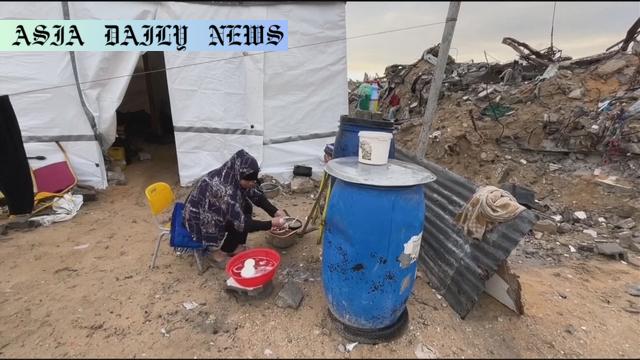Gaza: Many residents live in tents with damaged homes after conflict as humanitarian aid increases but challenges remain.

The Aftermath of Conflict in Gaza
The Gaza Strip is witnessing the devastating effects of months-long conflict with Israel, following a fragile ceasefire that began on January 19, 2024. Despite the cessation of hostilities, tens of thousands of residents are struggling to rebuild their lives. Communities are housed in makeshift tents or temporary shelters due to the overwhelming destruction caused by the fighting.
Severe Damage Across the Region
The United Nations has estimated that 92% of homes in Gaza have been damaged or destroyed, leaving countless families without a place to live. The scale of destruction has compounded an already dire humanitarian crisis in the region. For individuals like Ahmed al Habil, a 33-year-old Gaza resident, returning home has been a grim realization of the devastation. His house, among many others, was reduced to rubble during the height of the conflict.
Challenges in Providing Aid and Shelter
Although humanitarian aid has gradually increased following the ceasefire, challenges persist on multiple fronts. Israeli authorities report that 17,000 trucks carrying aid have entered Gaza since the truce began. However, key supplies, including temporary housing units and construction machinery, have yet to arrive. Hamas has accused Israel of delaying these critical supplies, impacting efforts to clear debris and rebuild essential infrastructure.
Living in Despair
Families like Ahmed al Habil’s have faced intense hardships. Living in a tent on the outskirts of a residential area, he and his family endure the freezing cold and fear of their makeshift shelter being blown away by strong winds. As he holds his daughters close, the uncertainty of their future weighs heavily on his mind. He echoes a sentiment shared by many: the pain of displacement and the lack of stability have left lasting scars.
The Fear of Returning Violence
Another pressing concern among Gaza residents is the looming end of the current truce on March 1. Many fear the resumption of violence and its devastating consequences. After enduring months of upheaval, families worry they will not have the resilience to withstand further hardship. For al Habil, returning to the street or living on someone else’s land is not a long-term solution. He hopes for a swift resolution to housing shortages and lasting peace in the region.
A Call for Global Action
As the international community watches, the situation in Gaza serves as a sobering reminder of the human cost of conflict. Immediate efforts must focus on providing shelter, clearing debris, and ensuring basic services for the devastated population. Aid organizations, governments, and NGOs have a crucial role to play in addressing these urgent needs while fostering dialogue and diplomacy to prevent further escalations in violence.
Conclusion
The plight of Gaza’s residents underscores the importance of sustained humanitarian efforts and the need for enduring peace. Beyond the physical rebuilding of homes, the psychological toll on families and children must not be overlooked. As negotiations for extending the truce continue, global attention and resources are vital to help those affected rebuild their lives and secure a path toward stability and safety.
Commentary
Challenges Amidst a Fragile Ceasefire
The situation in Gaza serves as a stark reminder of the human cost of prolonged conflict. Despite the ceasefire, the devastation is far from over for the families who lost everything. Rebuilding efforts are hamstrung by bureaucracy, inadequate aid supplies, and logistical hurdles. It is essential that all parties prioritize the delivery of critical resources to those in desperate need.
The Psychological Toll on Families
Beyond the physical destruction, the psychological impact of this crisis cannot be understated. For individuals like Ahmed al Habil and his family, the constant displacement, uncertainty, and fear of renewed violence have created a sense of despair. It is not just about rebuilding homes but also about restoring a sense of normalcy and security for these families, particularly children, who are most vulnerable in such volatile situations.
Global Responsibility to Act
The international community has a moral responsibility to intervene in meaningful ways. Aid organizations must push for greater access to Gaza, while diplomatic efforts should focus on ensuring the ceasefire holds beyond March 1. It’s imperative to foster dialogue between conflicting parties to prevent a return to violence and enable the rebuilding process to move forward without delay. The world must not look away as Gaza’s residents struggle to regain their footing amidst immense challenges.
Conclusion
Gaza’s crisis is not just a regional problem; it reflects the broader cost of unresolved conflicts worldwide. By addressing both immediate needs and long-term solutions, there is hope for not just rebuilding physical structures but also healing the scars of war for the people of Gaza. Let us hope that collective action will lead to a brighter and more stable future for this long-suffering region.


